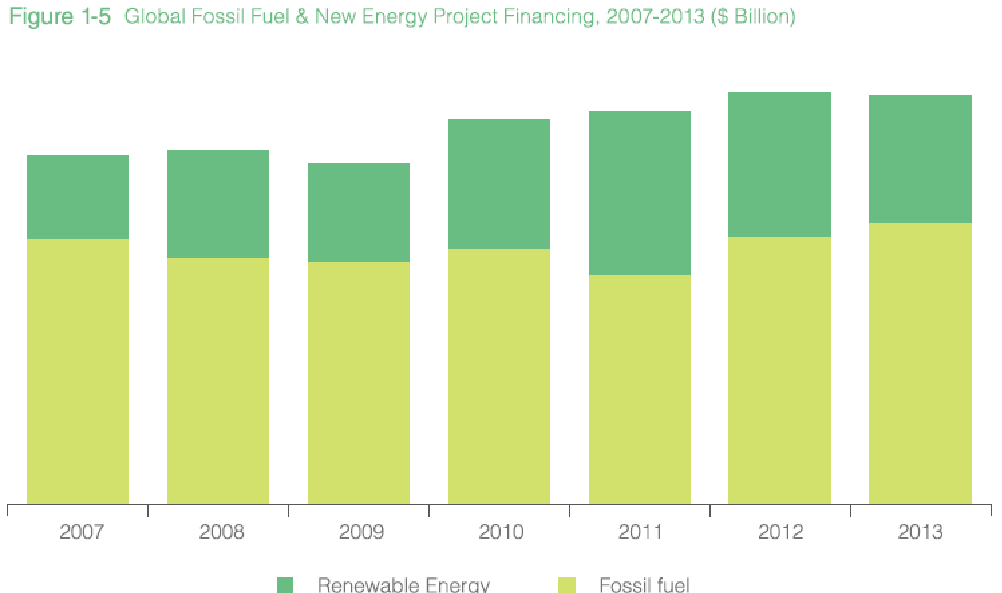
Nearly 39 gigawatts of new solar photovoltaic (PV) power generation capacity was installed worldwide in 2013, a 38 percent year-over-year increase. That brought the amount of solar power generation capacity installed worldwide as of end of last year to 140.6 GW, up from 101.9 GW in 2012, according to Hanergy Energy Holding Group and China New Energy Chamber of Commerce's Global Renewable Energy Report 2014.
Hanergy and CNECC's 2014 report shows a dramatic shift in the geography of solar power deployment last year, illustrating that installations in China, and the Asia-Pacific region more broadly, far outpaced those of Germany and Europe, as well as those for the U.S. and the Americas region.
While Germany and Europe have been scaling back government incentives to install solar and renewable energy systems, Japan instituted a generous solar energy feed-in tariff (FiT) in July 2012 in the wake of the Fukushima nuclear power plant disaster. Japan's renewable power generation capacity rose by 5.86 million kilowatts with solar power accounting for 90 percent of the total, according to a Japan Times news report. That's equal to the cumulative total in Japan prior to the launch of the solar FiT.
For its part, China has upped national strategic targets for new solar power generation capacity and has been reinforcing that with market-based incentives, focusing particularly on trying to stimulate uptake in the residential sector. Responding to growing public discontent, as well as the rapidly rising social, environmental and economic costs of its dependence on fossil fuels, China's government is experimenting with solar and renewable energy FiTs and cap-and-trade markets. It's also providing consumers incentives to purchase plug-in electric and fuel-cell electric vehicles (PEVs and FCEVs).
Solar shift from Europe to Asia
“The global solar market is shifting from Europe to Asia,” Hanergy and CNECC state in press release announcing their Global Renewable Energy Report 2014. China installed 12 GW of new solar PV power generation capacity in 2013, a whopping 232 percent year-over-year increase. New solar PV power capacity in Germany, in contrast, dropped a sharp 56.5 percent to 3.3 GW, while Italy's fell 55 percent to 1.6 GW.
China also accounted for a much greater share of global solar industry financing. Some $23.56 billion of solar energy finance flowed through China's market in 2013, “equivalent to the entire amount raised in Europe,” the report authors highlight.
"Our research shows that China has already become the world's biggest solar market. Now the country is moving to a more green and sustainable model of development which will drive future global growth in renewable energy," Li Hejun, chairman and CEO of Hanergy and president of the China New Energy Chamber of Commerce, was quoted as saying, adding that:
"Governments are turning to greater use of renewable energy to tackle pollution and deliver energy security, underpinning growth momentum in the global renewable energy industry."
The renewable energy transition continues
The transition from fossil fuels to renewable energy continues worldwide, they wrote. Globally, energy generation increased to 22,513.8 terawatt-hours, up 4.3 percent from 2013. Renewable energy generation rose at a 13 percent annual rate, accounting for 5.2 percent of total world output.
A leading integrated manufacturer of thin-film CIGS (cadmium indium gallium selenide) solar photovoltaic (PV) technology, Hanergy and report co-sponsor CNECC noted that global thin-film solar production capacity totaled some 4 GW in 2013, a year-over-year rise of 20 percent from 2012.
Fossil fuels still dominate
Despite strong and faster renewable power capacity growth, fossil fuel power generation and project financing continue to dominate world energy markets, however, even as governments are singly and jointly striving to hammer out the details of a global climate treaty and deal with the rising costs and threats of greenhouse gas emissions and environmental pollution.
Global power generation increased 4.3 percent year over year in 2013, about the same pace as in 2012, reaching 22,523.8 terawatt-hours, according to the Hanergy-CNECC report. Fossil fuel power generation accounted for 70 percent of the global total, down slightly from 70.5 percent in 2012.
*Images credit: Hanergy, China New Energy Chamber of Commerce, "Global Renewable Energy Report 2014"

An experienced, independent journalist, editor and researcher, Andrew has crisscrossed the globe while reporting on sustainability, corporate social responsibility, social and environmental entrepreneurship, renewable energy, energy efficiency and clean technology. He studied geology at CU, Boulder, has an MBA in finance from Pace University, and completed a certificate program in international governance for biodiversity at UN University in Japan.














